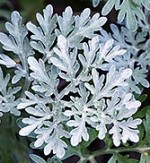 Also known as absinthe, this wood-based subshrub is native to Mediterranean Europe, temperate regions of Asia, and northern Africa where it grows in dry open areas, often on rocky slopes. It is a member of the aster family, Asteraceae, that also includes sunflowers, daisies, and lettuce. The plants are upright, well branched, and have stems and foliage coated with silky hairs. The greenish-gray leaves are 1.5 to 4 inches long, strongly aromatic when bruised, and two to three times pinnately dissected above, less so below. The pale yellow flowerheads appear in summer in drooping panicles and are not ornamentally interesting. The plants are grown for the silvery foliage that brightens the colors of hot pink, red, and oranges flowers, while blending the colors of pastel pink, blue, and purple flowers. Wormwood has been used in making both vermouth and absinthe but also has a long history of use in herbal remedies for a number of ailments. The genus name Artemesia is the name of the Greek goddess of chastity, the hunt and the moon. The specific epithet, absinthium, is the Latin name for wormwood.
Also known as absinthe, this wood-based subshrub is native to Mediterranean Europe, temperate regions of Asia, and northern Africa where it grows in dry open areas, often on rocky slopes. It is a member of the aster family, Asteraceae, that also includes sunflowers, daisies, and lettuce. The plants are upright, well branched, and have stems and foliage coated with silky hairs. The greenish-gray leaves are 1.5 to 4 inches long, strongly aromatic when bruised, and two to three times pinnately dissected above, less so below. The pale yellow flowerheads appear in summer in drooping panicles and are not ornamentally interesting. The plants are grown for the silvery foliage that brightens the colors of hot pink, red, and oranges flowers, while blending the colors of pastel pink, blue, and purple flowers. Wormwood has been used in making both vermouth and absinthe but also has a long history of use in herbal remedies for a number of ailments. The genus name Artemesia is the name of the Greek goddess of chastity, the hunt and the moon. The specific epithet, absinthium, is the Latin name for wormwood.
Type: Subshrub
Bloom: Dull yellow drooping flowerheads carried in panicles during the summer; ornamentally uninteresting
Size: 2-3’ H x 2’ W
Light: Full sun; tolerates some shade but becomes floppy
Soil: Lean to moderately fertile, dry, well-drained
Hardiness: Zones 3-9
Care: Prune in spring to encourage bushiness; shear if necessary in summer to improve appearance if plants get leggy.
Pests and Diseases: None of significance but root rot can occur if soil is too moist.
Propagation: Seed, division in autumn or spring, root cuttings, heel cuttings of side-shoots in early summer
Companion Plants: New Zealand flax, yucca, sneezeweed (Helenium), purple coneflower, yarrow cultivars such as ‘Cornation Gold’, black-eyed Susan.
Outstanding Selection: ‘Lambrook Silver’ (2.5’ tall, more silvery than species)